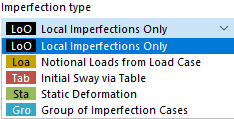Mithilfe von Imperfektionsfällen können die Rahmenbedingungen von Imperfektionen festgelegt werden. Sie regeln, ob die Imperfektionen als geometrische Vorverformungen, Ersatzlasten oder stockwerkweise Schiefstellungen berücksichtigt werden sollen.
Um die Stabilität von Tragwerken oder Tragwerksteilen nachzuweisen, sind in der Regel Imperfektionen zu erfassen. Grundsätzlich wird dabei zwischen geometrischen und strukturellen Imperfektionen unterschieden.
Unter geometrischen (äußeren) Imperfektionen sind Abweichungen von der planmäßigen Geometrie zu verstehen, die durch die Herstellung oder Montage bedingt sind. Dies können beispielsweise außerplanmäßige Lastaußermittigkeiten, Vorkrümmungen der Stabachse oder Stabschiefstellungen sein.
Strukturelle (innere) Imperfektionen sind ebenfalls durch die Herstellung bedingt und berücksichtigen beispielsweise Eigenspannungen oder eine ungleichmäßige Verteilung der Streckgrenze über den Querschnitt.
Anwendung im RFEM und RSTAB
Die Imperfektionsfälle bilden die Rahmenbedingungen für die Imperfektionen. Generell stehen im Programm folgende Imperfektionstypen zur Auswahl:
- Nur lokale Imperfektionen: Ansatz der Imperfektionen als Ersatzlasten, wobei Vorverdrehung und Vorkrümmung von Normalkräften abhängen
- Ersatzlasten aus Lastfall: Basis der Imperfektionen sind Lasten eines Lastfalls
- Anfangsschiefstellung über Tabelle: Stockwerkweise Abbildung der Imperfektionen
- Statische Verformung: Basis der Imperfektionen sind Verformungen eines Lastfalls oder einer Lastkombination
- Gruppe der Imperfektionsfälle: Kombination aus den Vorgaben mehrerer Imperfektionsfällen
Jeder Imperfektionsfall kann anschließend bestimmten Lastfällen oder Kombinationen zugeordnet werden.

